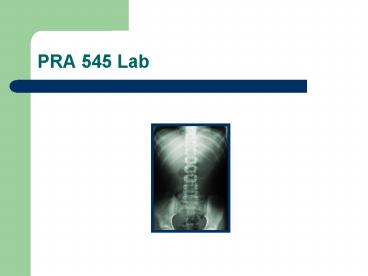PRA 545 Lab - PowerPoint PPT Presentation
1 / 30
Title:
PRA 545 Lab
Description:
C6 lateral antebrachium (forearm), thumb, index finger ... C8 dorsum of hand over 4th and 5th metacarpals, medial antebrachium. T1 Medial brachium ... – PowerPoint PPT presentation
Number of Views:35
Avg rating:3.0/5.0
Title: PRA 545 Lab
1
PRA 545 Lab
2
Patient Interaction
3
P.A.R.T.S.
4
Muscle Testing
- Muscle Testing (all muscles should be tested
bilaterally) - Muscle strength is graded on a 5-point scale, as
follows - 5/5 (normal) Complete anti-gravity AROM. Full
strength against resistance. - 4/5 (good) Complete anti-gravity AROM. Less
than full strength against resistance. - 3/5 (fair) Complete anti-gravity AROM but no
strength vs. resistance. - 2/5 (poor) Complete AROM only with gravity
eliminated. No strength vs. resistance. - 1/5 (trace) Muscle contraction palpable but no
active movement of joint. - 0/5 (zero) No palpable or visible muscle
contraction at all.
5
Muscle Testing
- Deltoid (C5)
- Procedure Have patient abduct arm 90º and bend
elbow 90º. Stabilize the shoulder, tell patient
to resist pressure, and then press down just
proximal to the elbow. - Wrist extensors (C6)
- Procedure Have patient extend wrist and hold in
that position. Stabilize lower forearm, and then
tell patient to hold wrist in extended position
while you attempt to move the wrist toward
flexion. - Wrist flexors (C7)
- Procedure Have patient flex wrist and hold in
that position. Stabilize lower forearm, and then
tell patient to hold wrist in flexion while you
attempt to move the patients wrist into
extension.
6
Muscle Testing
- Finger Flexors (C8)
- Procedure Have patient curl 4 fingers, holding
them close to one another. Curl your own 4
fingers, lock them with the patients 4 fingers,
and tell patient to resist as you seek to pull
them out of flexion. - Finger abductors/adductors (T1)
- Procedure Have patient hold 5 fingers of hand
rigidly apart from one another. Tell patient to
resist as you push 2 fingers toward each other,
testing finger abduction. Or have patient hold
fingers together rigidly, and attempt to separate
two fingers, thereby testing finger adduction.
7
Muscle Testing
- L4 Foot inversion
- Procedure Ask patient to resist as you push
against the dorsal and medial aspects of the head
of the first metatarsal bone, thereby testing
foot inversion and dorsiflexion. The muscle being
tested is tibialis anterior. - L5 Great toe extension
- Procedure Place your fingers on dorsal surface
of patients foot and ask him/her to extend the
great toe to reach toward them. Oppose this
motion by pressing on the nail of the great toe.
The muscle being tested is extensor hallicus
longus. - S1 Foot eversion
- Procedure Have patient plantar flex and evert
his/her foot, and oppose this motion by pushing
against the head the 5th metatarsal bone with the
palm of your hand. The muscles being tested are
the peroneus longus and brevis.
8
Deep Tendon Reflexes (DTRs)
- DTRs are graded as follows
- 0 absent
- 1 diminished
- 2 average/normal
- 2 slightly exaggerated
- 3 exaggerated
- 4 myoclonus
9
Deep Tendon Reflexes (DTRs)
- Biceps (C5)
- Brachioradialis (C6)
- Triceps (C7)
- No reflex for C8
- Pectoralis major (T1) some texts say there is no
T1 DTR
10
Deep Tendon Reflexes (DTRs)
- Patellar (L4)
- Hamstring (L5) some texts say there is no L5 DTR
- Achilles (S1)
11
Sensory
- Dermatome Testing Areas (Pinprick)
- C5 lateral brachium (upper arm)
- C6 lateral antebrachium (forearm), thumb, index
finger - C7 middle finger with narrow line extending to
wrist - C8 dorsum of hand over 4th and 5th metacarpals,
medial antebrachium - T1 Medial brachium
12
Sensory
- Dermatome Testing (Pinprick)
- L4 medial aspect of foot near first metatarsal
- L5 middle of dorsum of foot
- S1 lateral edge of foot near 5th metatarsal
13
Cervical Compression
14
Cervical Distraction
15
Lhermittes Sign
16
Soto-Hall
17
Straight Leg Raise (SLR)
18
SLR
19
Braggards Test
20
Bowstring Test
21
Kemps Test
22
Valsalva Meneuver
23
Femoral Nerve Stretch Test
24
Sacroiliac Compression
25
Gaenslens Test
26
Minors Sign
27
Plantar Reflex
28
Hoffmans Sign
29
UMN vs. LMN Lesion
30
(No Transcript)































